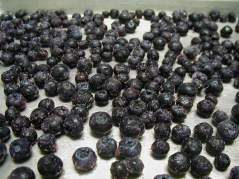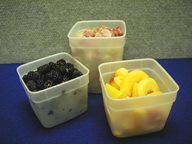
Fresh blueberries are in abundant supply in many states now. Blueberries are easy to freeze and maintain great quality for year-round use in favorites such as muffins, pancakes, and smoothies. They are nutrient dense and add freshness and flavor to meals.
Blueberries can be prepared for freezing using two methods. Dry pack and crushed or puŕeed. If you can’t freeze right after picking, refrigerate at 40 degrees F or below until ready to prepare and freeze. Work with small batches to prevent loss of nutrients and quality.
Dry pack is the easiest method. Most advice says do not wash the blueberries; the skins will toughen if frozen wet. (If you do want to rinse them off with clean water, be sure to completely dry again before packaging and freezing.) Remove leaves, stems, and any bruised or immature berries. Package berries into moisture vapor resistant packaging, either rigid plastic or flexible bags. Leave headspace.
Tray freezing before dry packaging allows blueberries to remain loose; and easier to remove in smaller amounts. Spread a single layer of berries on shallow trays and freeze. Once frozen, remove and promptly package. Return to the freezer immediately. When ready to use, remove from packaging and wash blueberries thoroughly by gently rubbing under cold running water.
Crushed or puréed is another method for freezing blueberries. To prepare for freezing, remove leaves, stems, and any bruised or immature berries. Wash blueberries thoroughly by gently rubbing under cold running water. Drain in a colander and blot dry with paper towels.
Crush, press through a fine sieve, or process in a food processor or blender. Mix with 1 to 1-1/8 cups sugar with each quart (2 pounds) of crushed berries or purée. Stir until sugar is dissolved. Package in freezer containers, leaving headspace. Label, seal, and freeze promptly. Keep an accurate inventory of the freezer. Use first in, first out method to use blueberries at peak quality.
If you plan on using your frozen berries at a later time to make jam or jelly, freeze them unsweetened or follow the proportions of sugar to berries in the jam recipe you will eventually use.
Taking time to freeze fresh blueberries with care will provide delicious, high quality, and nutritious fruit for use year-round.
(The links on this page can be found at https://nchfp.uga.edu)
###
 tray (like a cookie sheet), then carefully lift the tray into the freezer without causing berries to touch each other. As soon as they freeze, seal the berries in an airtight container and place them back into the freezer so they don’t get freezer burn.
tray (like a cookie sheet), then carefully lift the tray into the freezer without causing berries to touch each other. As soon as they freeze, seal the berries in an airtight container and place them back into the freezer so they don’t get freezer burn.








You must be logged in to post a comment.